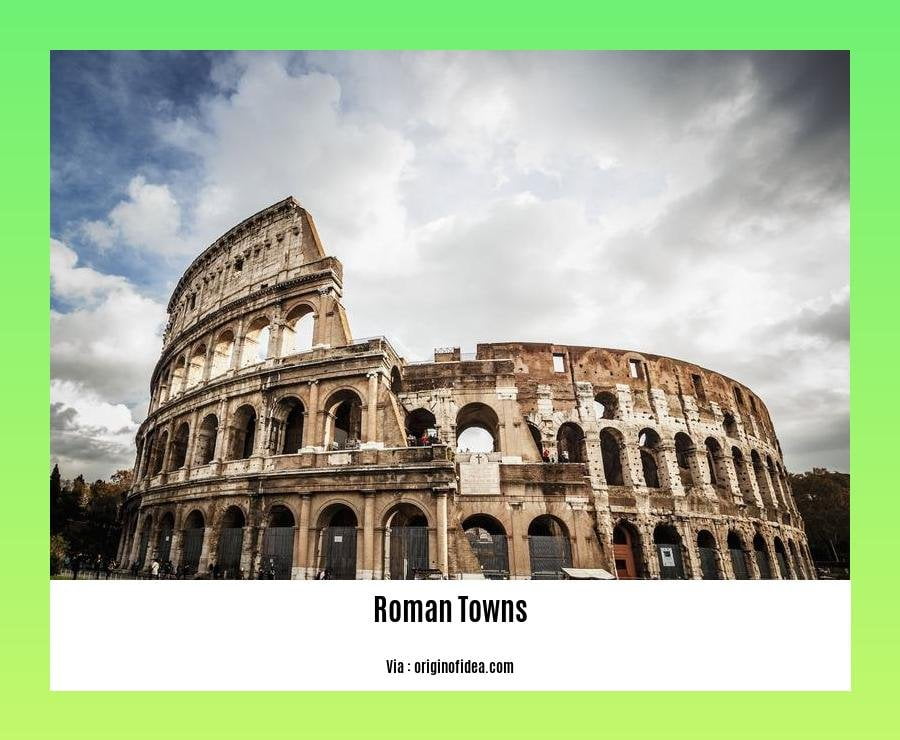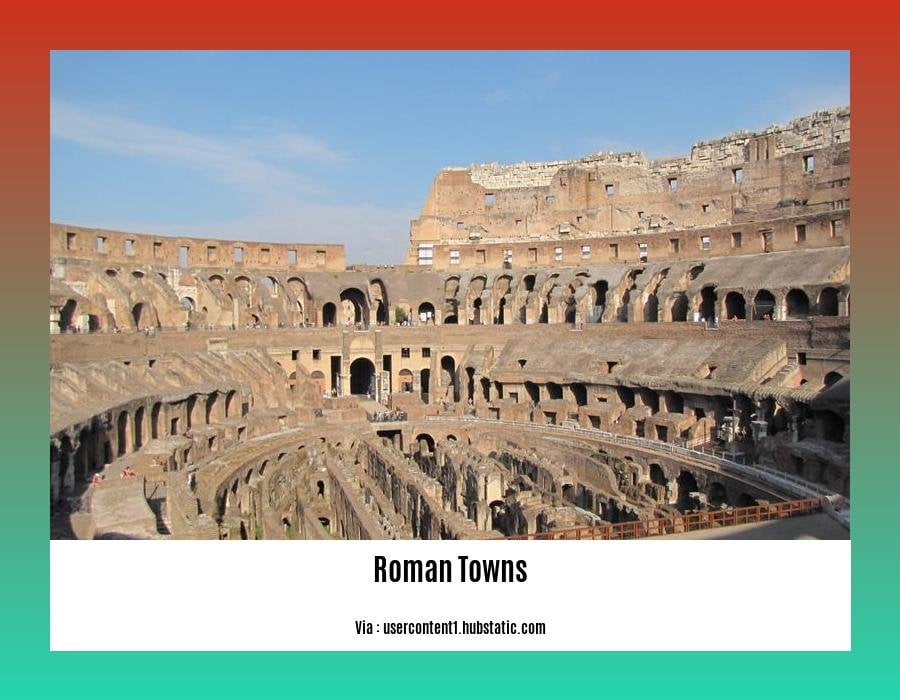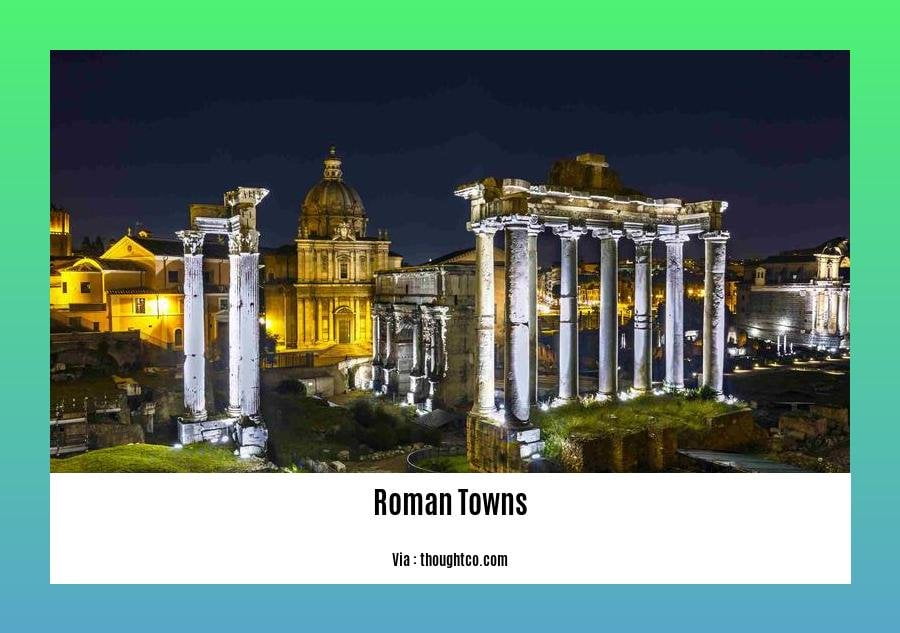Unearthing the Magnificence: Exploring the Allure of Famous Roman Towns
Delve into the enchanting world of ancient Roman towns as we embark on a captivating journey through time. From the grandeur of Pompeii to the architectural marvels of Ostia Antica, these famous Roman towns beckon with their rich history and cultural treasures. Unearthing forgotten tales and lost civilizations, this article will transport you back to a time of opulence, ambition, and extraordinary accomplishments. Join us as we unravel the architectural splendor, intricate societal customs, and immersive narratives that define these remarkable destinations. Prepare to be awed as we delve into the mesmerizing allure of these famous Roman towns, where echoes of the past still resound.
Key Takeaways:
- Athens, Greece: A significant city in the Roman Empire, known for its impressive skyline and ancient ruins.
- Alexandria, Egypt: Once a thriving Roman city with trade and cultural significance, now showcases a stunning modern-day skyline.
- Syracuse, Italy: Ancient ruins of Syracuse, a crucial Roman city in governance and trade, can be seen through aerial photographs.
- Antioch, Turkey: Boasting a stone church, Antioch was an important trade center in the Roman Empire.
- Carthage, Tunisia: The ancient Carthaginian ruins in Tunis serve as a reminder of Carthage’s influence in Roman trade.
- Ravenna, Italy: Ravenna’s Basilica of San Vitale showcases the architectural beauty of the city built shortly after Roman control.
- Mediolonum (Milan), Italy: The iconic Duomo Cathedral in Milan symbolizes the grandeur and architectural achievements of the Roman city.
- Constantinople, Turkey: The world-renowned Hagia Sophia in Constantinople, the new capital of the Roman Empire, is a recognizable structure on Earth.
Famous Roman Towns

Are you ready to embark on an awe-inspiring journey through time? Join me as we unmask the hidden splendor of famous Roman towns and immerse ourselves in their ancient allure. From the architectural wonders of Athens to the cultural significance of Alexandria, these legendary cities hold captivating tales waiting to be discovered.
Athens, Greece: Where Skyline Meets Ruins
Step foot in Athens, Greece, and you’ll instantly find yourself transported to a bygone era of grandeur and conquest. Known for its impressive skyline and ancient ruins, Athens was a cornerstone of the Roman Empire. As the birthplace of democracy and the land of the Parthenon, Athens has left an indelible mark on Western civilization. Soak in the panoramic views atop the Acropolis, trace the footsteps of philosophers along the Agora, and imagine the resounding echoes of ancient debates in the Theater of Dionysus. Athens is a testament to the endurance of human achievement.
Alexandria, Egypt: A City of Trade and Culture
Picture this: a stunning modern-day skyline concealing the remnants of a once-thriving Roman city. That’s Alexandria, Egypt. Located along the Mediterranean coast, this city was an emblem of trade, culture, and intellectual prowess during Roman times. Wander through the narrow streets and bustling marketplaces of the old city, where merchants from far and wide would gather to exchange goods and ideas. Explore the towering Bibliotheca Alexandrina, a modern tribute to the city’s ancient library that housed invaluable scrolls and manuscripts. Immerse yourself in the vibrant blend of Greek, Roman, and Egyptian traditions that permeate Alexandria’s narrow alleys and distinctive landmarks.
Syracuse, Italy: A Cradle of Roman Governance
Aerial photographs showcase the ancient ruins of Syracuse in Italy, a city that played a pivotal role in Roman governance and trade. Step back in time as you stroll through the paradise-like natural landscape of the Neapolis Archaeological Park. Marvel at the ancient Greek Theatre, a marvel of Roman engineering and a venue that hosted legendary performances. Syracuse, known for its strategic location and formidable military strength, proved to be a linchpin in Mediterranean affairs. Discover the remnants of ancient city walls, picturesque temples, and elegant statues – testaments to the city’s imperial past.
Antioch, Turkey: The Trade Hub of the Roman Empire
In the heart of modern-day Turkey lies Antioch, a city boasting a stone church and holding significant history as a center for trade in the Roman Empire. As one of the largest cities of its time, Antioch thrived as a vibrant cosmopolitan hub. Imagine the clatter of merchants haggling over exotic goods in the bustling marketplace, and the aromas of spices and silks wafting through the air. Archaelogical excavations have revealed stunning mosaics and intricate frescoes that adorned the city’s grand houses, showcasing the flair for luxury and artistic expression that permeated Antioch’s society.
Carthage, Tunisia: A Reminder of Roman Trade and Influence
Travel to Tunisia, and you’ll encounter the ancient Carthaginian ruins in Tunis. Carthage, once a mighty city-state and rival to Rome, now serves as a poignant reminder of its importance in Roman trade and influence. From the imposing ruins of the Baths of Antoninus to the awe-inspiring amphitheater, Carthage carries echoes of centuries past. Explore the thriving Roman Quarter, home to intricate villas with well-preserved mosaics and the majestic Odeon Theatre. Carthage beckons travelers to uncover the stories of triumph and tragedy that unfolded within its ancient walls.
Ravenna, Italy: Where Beauty Transcends Time
Let your senses be captivated by the allure of Ravenna, Italy. The Basilica of San Vitale, built a few decades after Roman control, stands as a testament to the architectural beauty that adorns this city. Step into the resplendent interior, where colorful mosaics depict scenes from biblical stories and celebrate the triumph of faith. Ravenna’s rich artistic heritage extends beyond its basilicas, with exquisite baptisteries and mausoleums showcasing the city’s unrivaled mastery of mosaic craftsmanship. Indulge in the ethereal atmosphere that permeates Ravenna, where time seems to stand still.
Mediolanum (Milan), Italy: The Roman City of Grandeur
Experience the grandeur of Mediolanum, now known as Milan, Italy. Dominating the city’s skyline is the iconic Duomo Cathedral, a symbol of the Roman city and its architectural achievements. Magnificent arches, intricate spires, and vibrant stained glass windows transport visitors to another world. But Milan’s Roman heritage extends beyond its remarkable cathedral. Explore the remnants of ancient Roman walls, wander through the Sforza Castle, and visit the grand amphitheater at Mediolanum Forum. Milan holds the key to unlocking the marvels of Roman engineering and the splendor of a city steeped in history.
Constantinople, Turkey: The Jewel of the Roman Empire
Prepare to be awestruck by the world-renowned Hagia Sophia in Constantinople, now Istanbul, Turkey. As one of the most recognizable places on Earth, it stood as the new capital of the Roman Empire. Marvel at the grandeur of domed architecture and intricate mosaics that span centuries of Roman, Byzantine, and Ottoman influence. Step into the vast interior, where artistry and spirituality intertwine, and history whispers its secrets. Constantinople offers a glimpse into the thriving cultural tapestry of the Roman Empire, leaving visitors spellbound by its sheer magnificence.
Let these famous Roman towns unlock the portals to a vibrant past, where empires rose and fell, and the echoes of ancient civilizations can still be heard. Immerse yourself in tales of glory, wander through architectural marvels, and trace the footsteps of legionnaires and scholars. These towns, frozen in time, are waiting to reveal their secrets. Are you ready to unearth the magnificence of these famous Roman towns?
Do you know if Spain celebrates the Day of the Dead? Find out more about this fascinating cultural tradition in Spain: do spain celebrate day of the dead
Are you curious about the evolution of human rights in India? Discover the historical milestones and progress made in protecting human rights in India: evolution of human rights in india
The Allure of Ostia Antica: A Glimpse into Roman Port Life

Located 15 miles southwest of Rome, Ostia Antica offers a mesmerizing journey back in time to the thriving ancient port city that played a vital role in supplying Rome with imports. With its rich historical significance, well-preserved ruins, and captivating archaeological discoveries, Ostia Antica stands as a remarkable testament to the grandeur of ancient Rome.
Historical Significance
Ostia Antica holds the distinction of being the first Roman colony and served as a crucial harbor city during ancient times. Its name, derived from Latin meaning “mouth,” aptly describes its location at the mouth of the Tiber River. As the main port for Rome, Ostia Antica facilitated trade and commerce with various parts of the vast Roman Empire.
(Source: Wikipedia)
Well-Preserved Ruins and Archaeological Discoveries
One of the most alluring aspects of Ostia Antica is its remarkably preserved ruins, offering a window into the daily life, architecture, and culture of ancient Rome. Visitors can explore the sprawling site covering approximately 50 hectares, which includes awe-inspiring mosaics and frescoes. These artifacts provide valuable insights into the vibrant society that thrived over 2,000 years ago.
(Source: Culture Trip)
Commercial Importance
As the main port of Rome, Ostia Antica played a crucial role in the economic development of the city. It served as a bustling hub for trading goods, including luxurious items, foodstuffs, and raw materials, transported by ships from different regions of the empire. The economic prosperity of Rome heavily relied on the efficient functioning of Ostia Antica.
(Source: TheTravel)
Comparison to Pompeii
While both Ostia Antica and Pompeii offer glimpses into ancient Roman life, Ostia Antica provides a unique and less crowded experience. Unlike the frequently bustling and tourist-filled streets of Pompeii, Ostia Antica offers a more peaceful and intimate setting, allowing visitors to immerse themselves in the historic ambiance without distraction. It is the perfect destination for those seeking a deeper connection with Roman history and a serene exploration of the past.
(Source: TheTravel)
Key Takeaways:
- Ostia Antica, located near Rome, was the first Roman colony and served as a vital harbor city.
- Its remarkably preserved ruins, including mosaics and frescoes, provide valuable insights into ancient Roman life.
- Ostia Antica played a crucial role in Rome’s economic development as the main port for trade.
- Unlike Pompeii, Ostia Antica offers a more peaceful and intimate experience, making it a must-visit destination for history enthusiasts.
Sources:
– Wikipedia
– Culture Trip
Tarraco: A UNESCO World Heritage Site in Modern-Day Tarragona
The Archaeological Ensemble of Tarraco stands as a testament to the Roman presence and influence in Spain. This UNESCO World Heritage site, located in Tarragona, Spain, was a major administrative and mercantile city in Roman Spain. It served as the center of the Imperial cult for all the Iberian provinces.
The significance of Tarraco lies in its well-preserved Roman buildings, some of which date back to pre-Roman origins. For instance, the Pilate’s offices, believed to have Cyclopean walls of pre-Roman origins, are said to have served as the palace of Augustus. Other notable structures at the site include a Roman amphitheater and an aqueduct.
Designated as a UNESCO World Heritage site in 2000, Tarraco is one of the largest archaeological sites of Roman Hispania in Spain. Its preservation and size emphasize the importance of understanding and appreciating the history of the Roman Empire in the Iberian Peninsula.
Visitors to Tarraco can embark on a journey through history by exploring the site on foot, by wheels, or even by sea. The city offers a unique experience, allowing visitors to witness the medieval, civil, and religious architectural influences, as well as the Catalan modernist legacy. Guided tours are available to ensure a deeper understanding of the historical significance of the site.
Unearthing the magnificence of Tarraco provides an opportunity to delve into the architectural splendor and societal customs of an ancient Roman town. Through vivid descriptions and immersive narratives, visitors can transport themselves back in time to the mesmerizing allure of this UNESCO World Heritage site.
Key Takeaways:
- The Archaeological Ensemble of Tarraco in Tarragona, Spain, is a UNESCO World Heritage site.
- Tarraco was a major administrative and mercantile city in Roman Spain and the center of the Imperial cult for the Iberian provinces.
- The site boasts well-preserved Roman buildings, including the Pilate’s offices, a Roman amphitheater, and an aqueduct.
- Tarraco is one of the largest archaeological sites of Roman Hispania in Spain and was designated as a UNESCO World Heritage site in 2000.
- Visitors can explore the site on foot, by wheels, or by sea, witnessing the architectural influences and the Catalan modernist legacy.
Sources:
Nîmes: Roman Architecture and Heritage in the South of France
Nîmes, located in the picturesque region of southern France, is a treasure trove of Roman architecture and rich cultural heritage. This charming city is renowned for its historical significance and the well-preserved remnants of the Roman Empire that still grace its streets. From magnificent amphitheaters to intricate temples, Nîmes offers an immersive experience that transports visitors back in time to the glorious days of ancient Rome.
The Marvelous Roman Relics of Nîmes
1. Roman Amphitheater:
Standing proudly in the heart of Nîmes, the Roman Amphitheater is a remarkable testament to Roman engineering and grandeur. With its towering walls that reach an impressive height of 69 feet and the capacity to seat 24,000 spectators, this amphitheater truly showcases the architectural prowess of the Romans. Once a bustling hub for thrilling gladiator fights and gripping entertainment, it now stands as a symbol of Nîmes’ rich historical past.
2. Maison Carrée:
The Maison Carrée, a beautifully preserved Roman temple, is another jewel in Nîmes’ architectural crown. This stunning structure captivates visitors with its immaculate craftsmanship and intricate details. As one of the best-preserved temples in the world, it offers a glimpse into the artistic excellence of the Romans and their dedication to honoring the gods.
3. Jardin de La Fontaine:
The Jardin de La Fontaine is an enchanting park that showcases the harmonious blend of Roman and French culture. Strolling through its lush green pathways, visitors can marvel at the remains of the Temple of Diana, which dates back to the Roman era. This serene oasis allows individuals to immerse themselves in the historical ambiance while enjoying the beauty of nature.
4. Temple of Diana:
Nestled within the Jardin de La Fontaine, the Temple of Diana stands as a testament to the religious beliefs of ancient Romans. Although only a few columns remain, these remnants whisper tales of devotion and spiritual practices that were an integral part of Roman society.
5. Porte d’Auguste:
The grand Porte d’Auguste, a Roman triumphal arch, once marked the entrance to the city of Nîmes. This magnificent structure reminds visitors of the city’s significance as a gateway to the Roman Empire. Its intricate carvings and imposing presence stand as a testament to the power and influence of Rome.
With its diverse array of Roman ruins, Nîmes provides an immersive experience that allows visitors to delve into the ancient world and gain a deeper understanding of Roman architecture and culture.
Cultural Richness and Delightful Explorations
Beyond its remarkable Roman relics, Nîmes is also renowned for its rich textile heritage. The city’s proud tradition of textile production is evident in its historical buildings and museums. Visitors have the opportunity to explore the intricate craftsmanship and expertise that have shaped Nîmes’ cultural identity.
Adding to its allure, Nîmes boasts a thriving café culture that offers a delightful escape for travelers. The city’s numerous cafes provide a relaxed atmosphere where visitors can sip on a cup of coffee, savor local delicacies, and immerse themselves in the vibrant ambiance.
Unearthing the Hidden Gem of Roman Antiquity
Often referred to as a hidden gem of Roman antiquity, Nîmes offers a unique opportunity for travelers to explore the architectural wonders and experience the rich history of the Roman Empire. Its captivating Roman relics, from the awe-inspiring amphitheater to the meticulously crafted Maison Carrée, transport visitors to a bygone era of grandeur and intrigue.
Key Takeaways:
– Nîmes, located in the south of France, is renowned for its Roman architecture and heritage.
– The Roman Amphitheater and Maison Carrée showcase the remarkable architectural prowess of the Romans.
– The Jardin de La Fontaine and Temple of Diana offer a serene setting to immerse oneself in history and nature.
– The Porte d’Auguste stands as a grand triumphal arch, symbolizing the city’s significance in the Roman Empire.
– Nîmes also boasts a rich textile heritage and a thriving café culture that adds to its charm.
Sources:
– National Geographic: The inside guide to Nîmes, the French city packed with Roman history
– Culture Travel: 5 Ancient Roman Empire Ruins in Nîmes, France
FAQ
Q1: What is the historical significance of Ostia Antica?
A1: Ostia Antica was an important harbor city and the main port of Rome during ancient times, facilitating trade and commerce with various parts of the Roman Empire.
Q2: What can visitors expect to see at Ostia Antica?
A2: At Ostia Antica, visitors can explore well-preserved ruins, including impressive mosaics and frescoes. They can also see various structures such as the amphitheater, temples, shops, and bathhouses.
Q3: How did Ostia Antica contribute to the economic development of Rome?
A3: As the main port of Rome, Ostia Antica played a crucial role in the economic development of the city. It served as a hub for trading goods, including luxury items, foodstuffs, and raw materials, from different regions of the empire.
Q4: How does Ostia Antica compare to Pompeii?
A4: While both Ostia Antica and Pompeii are ancient Roman sites, Ostia Antica offers a more peaceful and less touristy environment. It provides a different experience for those seeking a more intimate connection with Roman history.
Q5: What makes Nîmes a notable Roman town?
A5: Nîmes in southern France has a rich Roman history and is known for its well-preserved Roman structures such as the Roman Amphitheater and the Maison Carrée. The city offers visitors a chance to immerse themselves in history and explore its architectural wonders.
















